What Does it Taste Like?
While potatoes don't have much flavor by themselves, they are fantastic at soaking up the flavors they're cooked with, and can take on a variety of textures from crispy to creamy depending on the cooking method you use.
Varieties we grow
Raspberry
A waxy variety with vibrant red skin and deep red flesh that retains its color when cooked. It has a smooth, creamy texture and a rich, earthy flavor with subtle sweetness. Its firm structure makes it ideal for roasting, grilling, and pan-frying, while its bold color adds visual appeal to potato salads and gratins.
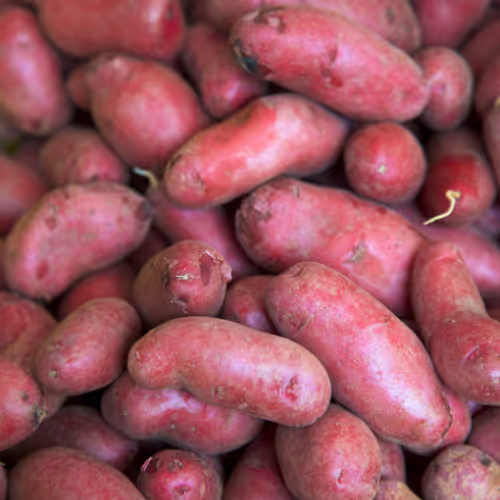
Amarosa
An all-purpose fingerling potato with vibrant red skin and deep red flesh that retains its color when cooked. It has a smooth, moist texture and a mild, slightly sweet flavor, making it perfect for roasting, frying, and vibrant potato salads. They even retain their vibrant color when cooked, so consider using them to make beautiful chips.
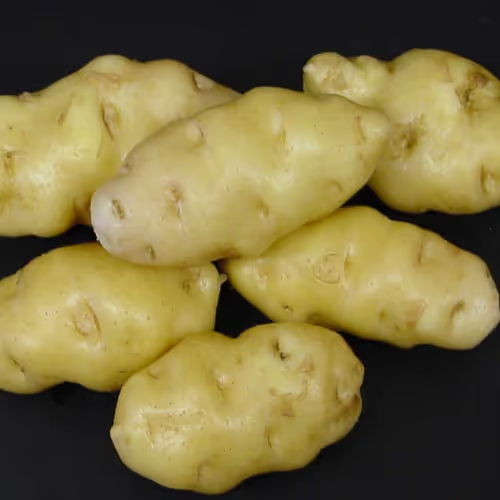
White Ozette
A waxy, nutty-flavored fingerling potato with a firm, almost wax candle-like texture. Its creamy white flesh stays intact when boiled or roasted, making it ideal for salads and pan-frying. The heirloom variety has a slightly sweeter, more complex taste than standard white potatoes.
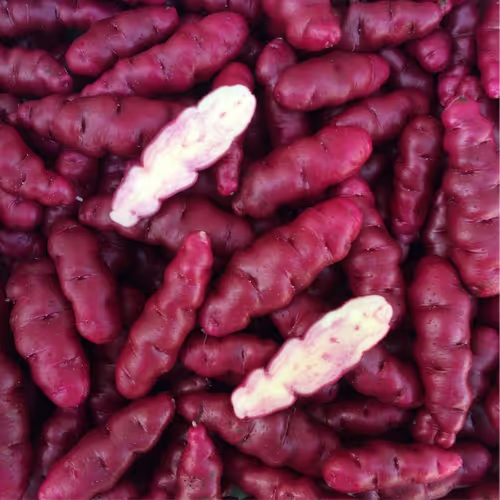
Red Ozette
A firm, waxy potato with a nutty, slightly earthy flavor and dense texture. Its red skin and yellow flesh hold up well in roasting and boiling, making it a great choice for rustic potato dishes and salads. The heirloom variety offers a unique depth of flavor compared to common red potatoes.
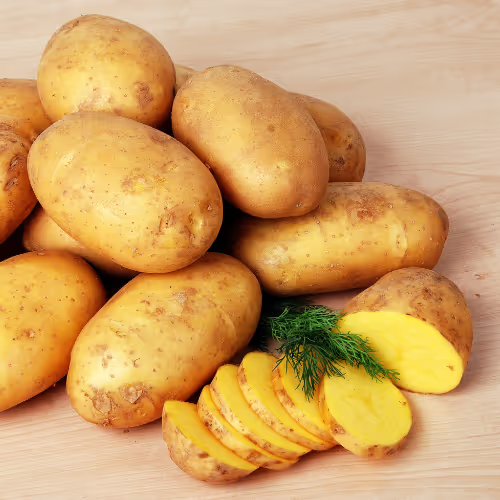
German Butterball
A rich, buttery-flavored all-purpose potato with a smooth, dense texture. Its golden flesh is slightly waxy yet creamy, making it perfect for roasting, frying, and gratins while still working well for mashing.

Dark Red Norland
A waxy potato with firm, moist flesh and a mild, slightly sweet flavor. Its thin, deep red skin and creamy texture make it ideal for boiling, roasting, and potato salads. It holds its shape well, resisting mushiness when cooked.
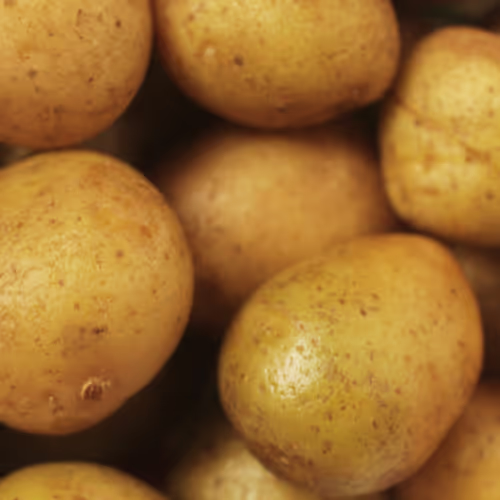
Yukon Gold
A versatile all-purpose potato with a buttery flavor and a smooth, creamy texture. It has medium starch content, making it excellent for mashing, roasting, and frying while still holding its shape in soups and stews.

Blackberry
This variety has a black skin and deep purple flesh, with a mild and slightly tangy flavor. It is a medium-starch potato, similar to Yukon Golds, which means it holds its shape well when cooked. It is good for roasting, grilling, or making hash browns.

Purple Majesty
This variety has a purple skin and a purple flesh, with a rich and slightly bitter flavor. It is a waxy (low-starch) potato, which means it is firm and moist when cooked. It is good for boiling, steaming, or making soups, casseroles, or potato salad.
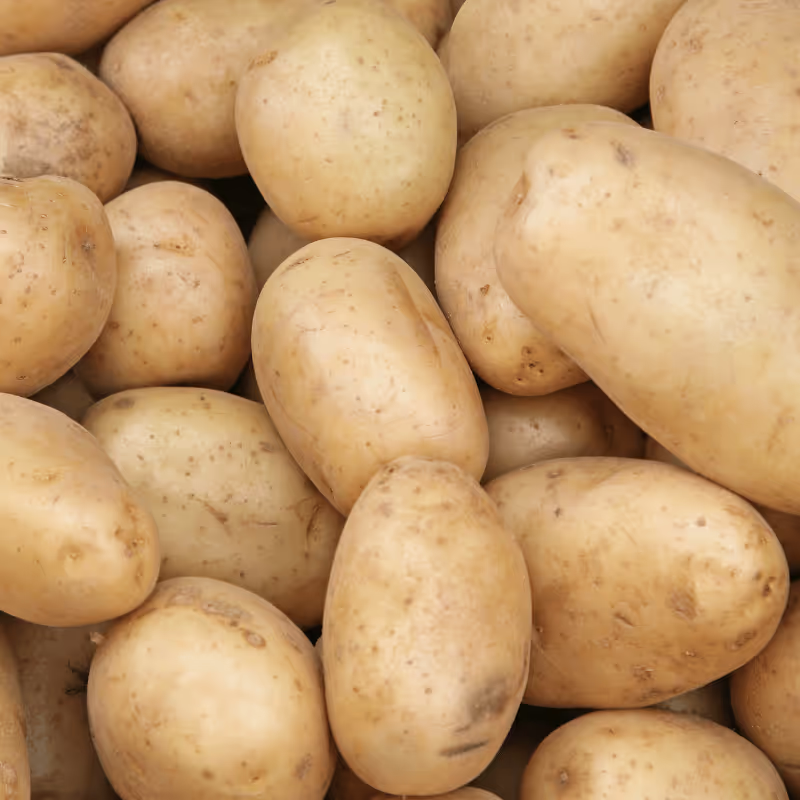
Charlotte
Charlotte: This variety has a yellow skin and a white flesh, with a delicate and slightly sweet flavor. It is a waxy (low-starch) potato, which means it is firm and moist when cooked. It is good for boiling, steaming, or making soups, casseroles, or potato salad.
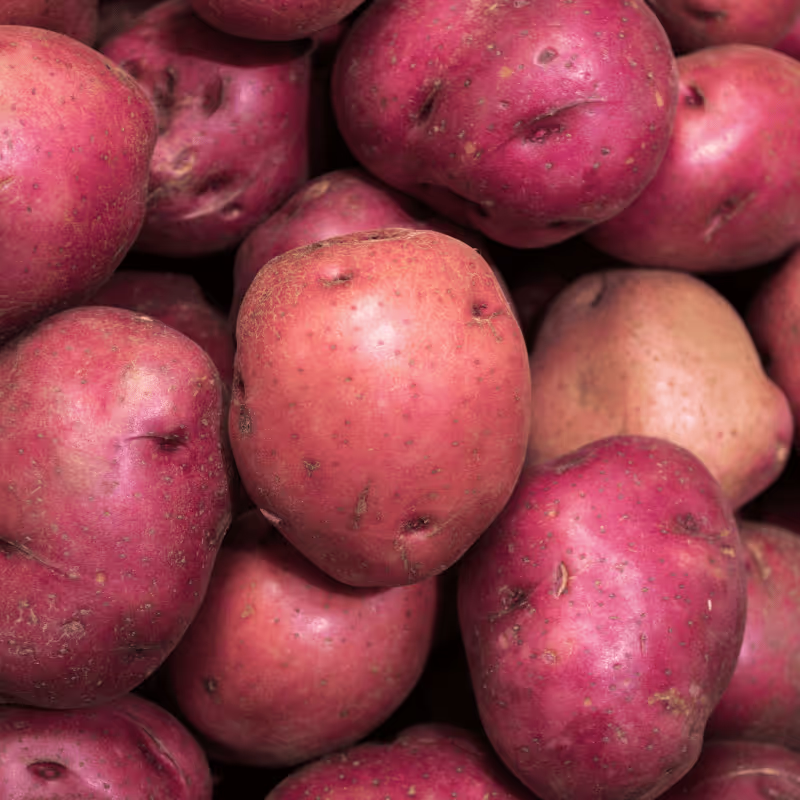
Adirondack Red
This variety has a red skin and a pink flesh, with a nutty and earthy flavor. It is a waxy (low-starch) potato, which means it is firm and moist when cooked. It is good for boiling, steaming, or making soups, casseroles, or potato salad.
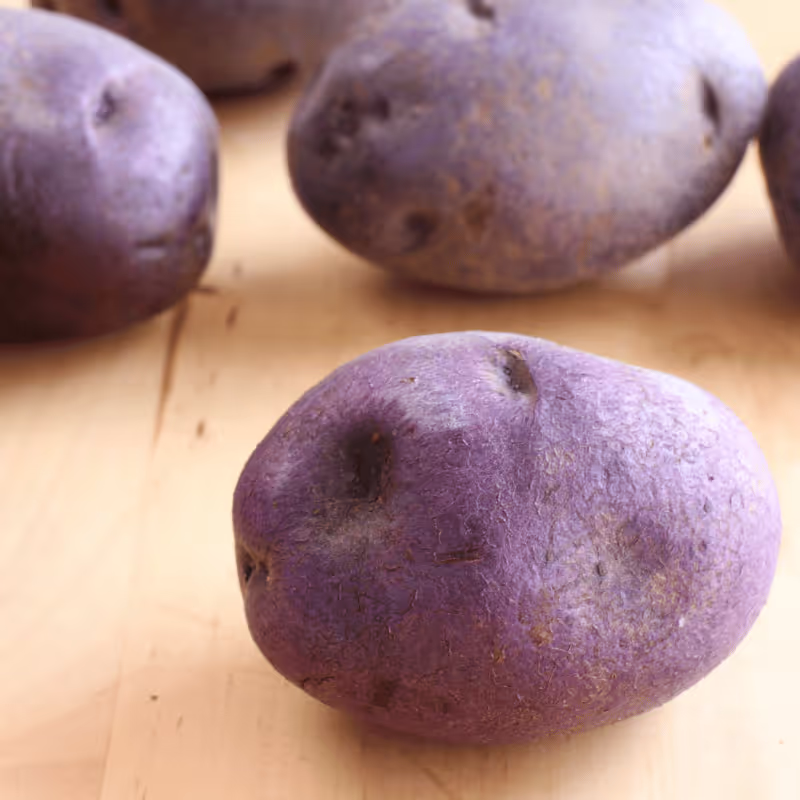
Hucklberry Gold
This variant of the classic Yukon Gold has a purple skin and a yellow flesh, with a creamy and buttery flavor. It is a medium-starch potato, which means it holds its shape well when cooked. It is good for roasting, mashing, or making salads.
Why Should I Eat It?
Potatoes are a nutrient-dense complex carbohydrate that can be part of a healthy and balanced diet. However, the way you prepare and eat potatoes can affect their nutritional value and health effects. For example, frying potatoes can add extra calories and fat, while peeling potatoes can reduce their fiber and vitamin content.
- Antioxidants: They are a good source of vitamin C, which is an antioxidant that helps protect your cells from damage and supports your immune system. One medium potato provides 28% of the recommended daily intake (RDI) of vitamin C. Potatoes also have other types of antioxidants, such as flavonoids, carotenoids, and phenolic acids Purple potatoes have the highest amount of antioxidants among potatoes.
- Potassium: Potatoes are loaded with potassium, which is a mineral that helps regulate your blood pressure and fluid balance. One medium potato provides 26% of the RDI of potassium. In fact, they have more potassium than bananas!
- Energy Boosting: They are a good source of vitamin B6, which is a vitamin that helps your body make energy and use amino acids, the building blocks of proteins. One medium potato provides 27% of the RDI of vitamin B6.
- Digestive Health: Potatoes are a great source of fiber, which is a type of carbohydrate that helps your digestion and lowers your cholesterol levels. One medium potato with the skin provides 3.8 grams of fiber, which is 15% of the RDI.contain resistant starch, which is a type of starch that is not digested in your small intestine, but instead feeds the beneficial bacteria in your large intestine. Resistant starch can improve your blood sugar control, reduce your appetite, and promote your gut health.
Potatoes

Year Round
Potatoes are the ultimate comfort food that can be transformed into countless delicious dishes with just a little heat and creativity. They come in different shapes, sizes, colors, and textures, and can range in consistency from waxy to starchy. Each variety of potato is a little unique which will determined what cooking method suits them best.
Recommended Storage
How Do I Store It?
Short Term
Potatoes are the ideal candidate for storing in a root cellar, but not many modern homes have those. In lieu of a root cellar, look for a cool, dry, dark place to store them. Don't wash them until you're ready to use them, as the moisture will cause them to spoil. Also, avoid direct sunlight as this will trigger chlorophyll-making (this is when your potatoes start to turn green) and cause the development of solanine, which can cause digestive issues. Also, keep them away from other produce that produces ethylene gas, such as onions, apples, and bananas, as this will cause them to spoil faster.
And never, ever store your potatoes in the fridge! The cold temperatures will convert the starches into sugars resulting in an oddly sweet spud.
Long Term
The shelf life on potatoes is pretty long, but there are several ways that you can store them to extend that life and make using them even easier:
- Freezer: Potatoes can be frozen cut into any shape you want. They make for a huge time-saver when it comes to prepping your ingredients, and they're one of the few types of produce that can actually benefit from freezing. Freezing removes a lot of excess moisture, which means that methods such as frying and roasting will yield a much crispier texture. To freeze your potatoes, begin by blanching them for a few minutes (the time will depend on how you cut them. You want them softened slightly but still firm) then drying them well. Place them on a lined baking sheet and pop in the freezer until frozen through, then store in an air-tight container for up to a year.
- Pickling: This may come as a surprise, but you can in fact pickle potatoes. A few things to note when pickling potatoes is that, since they are such a firm and dense vegetable, you'll want to parboil them for a few minutes before adding them to the jar, and you'll want to let the pickles sit for a week or two before eating. Also, since pickles don't have much flavor of their own, they will soak up the flavor of the brine, so don't over-season it.
- Dehydrating: These are a pantry staple! Potatoes can be dehydrated in slices, dices, or shreds, and are easily rehydrated. You can even dehydrated mashed potatoes to make your own instant mashed potatoes or as a base to a dry potato soup mix.
- Canning: Like many vegetables, potatoes are low-acid, which means they have to be canned in a pressure cooker to be shelf stable. You'll need to wash, peel, cut, and boil the potatoes before canning them.
How Do I Cook It?
Po-ta-toes! Boil them, mash them, stick them in a stew! There are so many ways to cook potatoes, depending on the type of potato and the desired texture and flavor. Some of the best cooking methods for potatoes are:
- Oven-roasting: This method produces potatoes that are crispy on the outside and creamy on the inside. It works well for waxy and medium starch potatoes such as Yukon Gold, red, new, and fingerling. To oven-roast potatoes, cut them into even pieces, toss them with oil and seasonings, and bake them in a single layer at a high temperature until golden and tender.
- Baking: This method cooks potatoes whole, resulting in a fluffy and dry texture. It works best for starchy potatoes like russets and long white potatoes. To bake potatoes, prick them with a fork, rub them with oil and salt, and bake them in a preheated oven until soft.
- Soups and Stews: Potatoes are a fantastic and filling addition to soups and stews. Typically, you want to stick with waxy, very low starch potatoes otherwise that starch will thicken your soup/stew base. But, there may be some times that you actually want that thickening action, such as creating a dairy-free creamy soup, in which case, the more starch the better! To add potatoes to your stews and soups, peel them if desired, cut them into bite-sized chunks, and simmer them in the soup or stew until fork-tender.
- Frying: Mmm French fries! This method cooks potatoes in oil, resulting in a crunchy and flavorful texture. It works well for starchier potatoes like russets. To fry potatoes, peel them if desired, cut them into thin slices or strips, and fry them in hot oil until golden and crisp.
- Mashing: A holiday favorite! This method cooks potatoes and then mashes them with a fork, masher, or mixer, resulting in a smooth and creamy texture. It works best for medium to high starch potatoes like russet, long white, and yellow potatoes. To mash potatoes, boil them until soft, drain them, and mash them with butter, milk, cream, cheese, or sour cream.
What Goes Well With It?
Potatoes are essentially a blank canvas for you to build the flavor of your dish upon, so they basically pair well with anything. Here are some of the classic parings to consider:
- Herbs: Potatoes love herbs! And they're not too picky about which herbs you add to them, though they shine the brightest with chives, rosemary, savory, and thyme.
- Garlic: Garlic potatoes are pure heaven! They do well with both fresh and dehydrated garlic, and even roasted garlic.
- Dairy: Potatoes make an excellent companion to cream, cheese, butter and sour creamy. Butter and cream will help make your mashed potatoes rich and creamy;
- Meats: The phrase "meat and potatoes" didn't just come out of thin air. This comforting combo is great on a chilly day and will definitely keep you full.
